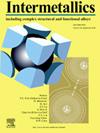The tribocorrosion behavior of the Cu-based glassy composite coating produced via high velocity air-fuel thermal spraying
IF 4.3
2区 材料科学
Q2 CHEMISTRY, PHYSICAL
引用次数: 0
Abstract
3Cr13 stainless steel (SS), commonly applied to marine engineering components such as bearings and drive shafts, is damaged by tribocorrosion. For improving the resistance of tribocorrosion, the Cu55Zr25Ti15Ni5 glassy composite coating is prepared via high-velocity air-fuel (HVAF) spraying technology on 3Cr13 SS, and the tribocorrosion experiment of the coating is investigated using friction and wear tester. The coating exhibits a multiphase structure, comprising amorphous-nanocrystalline region and oxide phase consisting of TiO2 and t-ZrO2, of which the amorphous-nanocrystalline phase accounts for about 53 %. The nanomechanical properties and the corrosion properties are investigated. The analysis of the tribocorrosion system (counter-balls, post-tribocorrosion solution, and wear tracks) is carried out using 3D scanner, inductively coupled plasma mass spectrometer (ICP-MS) and scanning electron microscope (SEM). Abrasive wear and fatigue wear mainly occur in the coating during tribocorrosion, and adhesive wear and chemical reaction wear are slight. As the load increases, tribo-film is formed on the surface of the coating and the wear rate decreases dramatically, due to the suppression of abrasive wear. The wear rate of the coating is only half of that of 3Cr13 SS at the load of 30N.
高速空气-燃料热喷涂法制备铜基玻璃状复合涂层的摩擦腐蚀行为
3Cr13不锈钢(SS),通常应用于船舶工程部件,如轴承和传动轴,被摩擦腐蚀损坏。为提高其耐摩擦腐蚀性能,采用高速空气燃料(HVAF)喷涂技术在3Cr13 SS上制备了Cu55Zr25Ti15Ni5玻璃状复合涂层,并利用摩擦磨损试验机对涂层进行了摩擦腐蚀实验研究。该涂层呈现多相结构,包括非晶纳米晶区和由TiO2和t-ZrO2组成的氧化相,其中非晶纳米晶相约占53%。研究了复合材料的纳米力学性能和腐蚀性能。利用三维扫描仪、电感耦合等离子体质谱仪(ICP-MS)和扫描电子显微镜(SEM)对摩擦腐蚀系统(反摩擦球、后摩擦腐蚀溶液和磨损轨迹)进行了分析。摩擦腐蚀时涂层主要发生磨粒磨损和疲劳磨损,粘着磨损和化学反应磨损轻微。随着载荷的增加,涂层表面形成摩擦膜,由于磨粒磨损受到抑制,磨损率急剧下降。在30N载荷下,涂层的磨损率仅为3cr13ss的一半。
本文章由计算机程序翻译,如有差异,请以英文原文为准。
求助全文
约1分钟内获得全文
求助全文
来源期刊

Intermetallics
工程技术-材料科学:综合
CiteScore
7.80
自引率
9.10%
发文量
291
审稿时长
37 days
期刊介绍:
This journal is a platform for publishing innovative research and overviews for advancing our understanding of the structure, property, and functionality of complex metallic alloys, including intermetallics, metallic glasses, and high entropy alloys.
The journal reports the science and engineering of metallic materials in the following aspects:
Theories and experiments which address the relationship between property and structure in all length scales.
Physical modeling and numerical simulations which provide a comprehensive understanding of experimental observations.
Stimulated methodologies to characterize the structure and chemistry of materials that correlate the properties.
Technological applications resulting from the understanding of property-structure relationship in materials.
Novel and cutting-edge results warranting rapid communication.
The journal also publishes special issues on selected topics and overviews by invitation only.
 求助内容:
求助内容: 应助结果提醒方式:
应助结果提醒方式:


